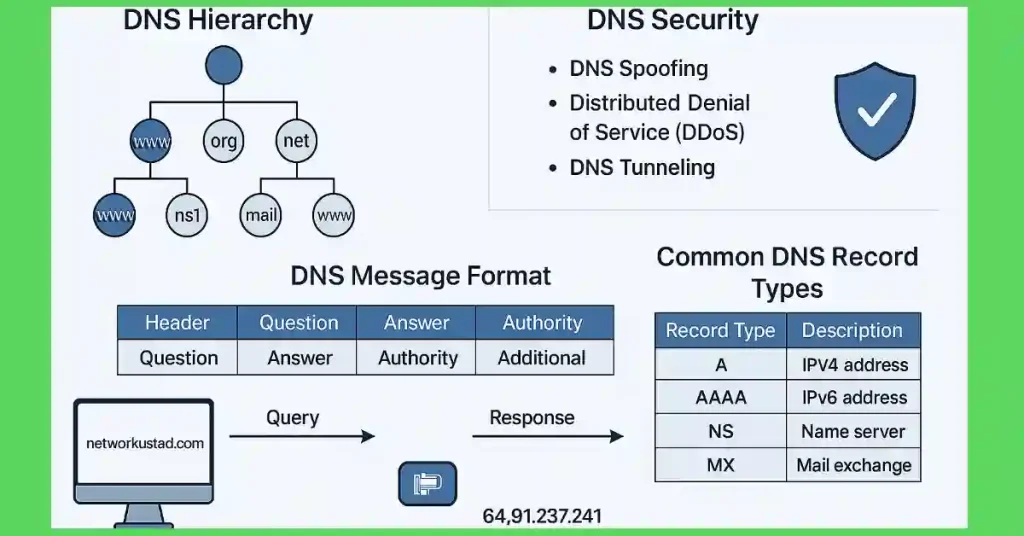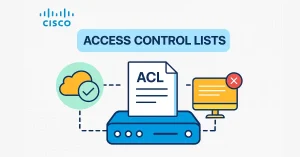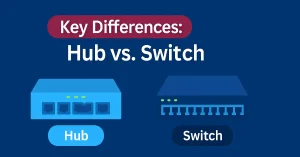The Domain Name System (DNS) is the backbone of modern networking, translating human-readable domain names like networkustad.com into machine-readable IP addresses such as 64.91.237.241. For CCNA and CCNP students, understanding DNS is critical because it underpins how devices communicate in IP networks, including Cisco-based infrastructures. Think of DNS as the Internet’s phone book, enabling seamless connectivity for websites, servers, and network devices.
DNS simplifies network management by allowing administrators to use memorable domain names instead of complex IP addresses. Whether you’re configuring a Cisco router, troubleshooting connectivity, or securing a network, mastering DNS is essential for passing CCNA and CCNP exams and excelling in real-world networking roles. This article dives deep into DNS concepts, including its hierarchy, message formats, record types, and practical applications for Cisco networking.
The domain name system defines an automatic service that matches resource names with the required numeric IP address, including query format, responses, and data. The domain name system protocol uses a single format called a message for all types of client queries and server responses, error messages, and the transfer of resource record information bet]. Ween servers.
The domain name system is its complete network. If one domain name server doesn’t know how to translate a particular domain name, it asks for another domain name system, and so on, until the correct IP address is returned. The Figure below illustrates the steps involved in the domain name system resolution.
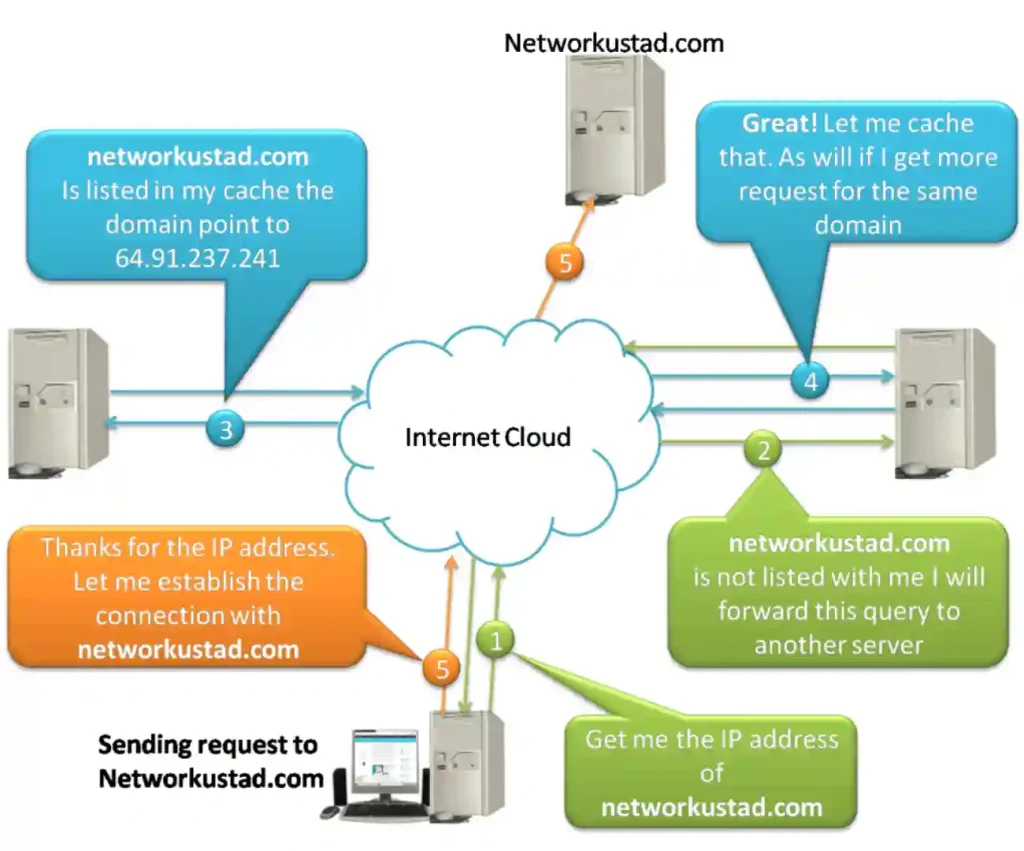
DNS Message Format
The Domain Name System (DNS) uses a standardized message format for all client queries, server responses, error messages, and resource record transfers between servers. This format, called a DNS message, consists of two types: query and response. Both share the same structure, which includes five sections: Header, Question, Answer, Authority, and Additional.
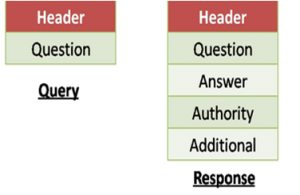
Header
The header is a 12-byte section that contains control fields defining the message type and structure. Key fields include:
- ID (16 bits): A unique identifier for the query, copied in the response.
- QR (1 bit): Query (0) or Response (1).
- Opcode (4 bits): Type of query (e.g., 0 for standard query).
- AA (1 bit): Authoritative Answer flag, indicating if the response is from an authoritative server.
- TC (1 bit): Truncation flag, indicating if the message was truncated.
- RD (1 bit): Recursion Desired, set by the client to request recursive resolution.
- RA (1 bit): Recursion Available, indicating if the server supports recursion.
- RCODE (4 bits): Response code (e.g., 0 for no error, 3 for name error).
- QDCOUNT: Number of entries in the Question section.
- ANCOUNT: Number of entries in the Answer section.
- NSCOUNT: Number of entries in the Authority section.
- ARCOUNT: Number of entries in the Additional section.
Question
The Question section contains the query details, including:
- QNAME: The domain name being queried (e.g., networkustad.com).
- QTYPE: The type of record requested (e.g., A, AAAA, MX).
- QCLASS: The class of the query (typically IN for Internet).
Answer
The Answer section contains resource records (RRs) that resolve the query. For example, a query for networkustad.com might return an A record with the IP address 64.91.237.241.
Authority
The Authority section lists name servers authoritative for the queried domain, often including NS records.
Additional
The Additional section provides supplementary records related to the query, such as the IP address of an authoritative name server.
Example DNS Query and Response:
| Field | Query Example | Response Example |
|---|---|---|
| Header | ID: 1234, QR: 0, RD: 1, QDCOUNT: 1 | ID: 1234, QR: 1, AA: 1, ANCOUNT: 1 |
| Question | QNAME: networkustad.com, QTYPE: A, QCLASS: IN | Same as query |
| Answer | – | A: 64.91.237.241 |
| Authority | – | NS: ns1.networkustad.com |
| Additional | – | A: 192.0.2.1 (for ns1.networkustad.com) |
This format ensures DNS communication is efficient and standardized across all network devices.
Common DNS Record Types
DNS servers store various record types to map domain names to resources. Below is a table of common DNS record types relevant to CCNA and CCNP studies:
| Record Type | Description | Example |
|---|---|---|
| A | Maps a hostname to an IPv4 address. | networkustad.com → 64.91.237.241 |
| AAAA | Maps a hostname to an IPv6 address. | networkustad.com → 2001:db8::1 |
| NS | Specifies an authoritative name server for a domain. | example.com → ns1.example.com |
| PTR | Maps an IP address to a hostname (used in reverse DNS lookups). | 241.237.91.64.in-addr.arpa → networkustad.com |
| SRV | Specifies the location of services (e.g., port and hostname). | _sip._tcp.example.com → srv1.example.com |
| TXT | Stores arbitrary text, often for metadata or verification. | example.com → “v=spf1 mx -all” |
| MX | Specifies mail exchange servers for a domain. | example.com → mail.example.com |
| CNAME | Start of Authority contains administrative info about a domain. | www.example.com → example.com |
| SOA | Start of Authority contains administrative information about a domain. | example.com → (serial, refresh, retry, etc.) |
Configuring DNS on Cisco Devices
For CCNA and CCNP students, understanding how to configure DNS on Cisco routers is essential for network administration. Below is an example of configuring a Cisco router to use DNS for name resolution.
Step-by-Step Configuration
Enable DNS Lookup: Enable the router to perform DNS queries.Router(config)# ip domain-lookup
Specify DNS Servers: Configure the router to use one or more DNS servers (e.g., Google’s public DNS servers). Router(config)# ip name-server 8.8.8.8 Router(config)# ip name-server 8.8.4.4
Set the Default Domain Name (Optional): Specify a default domain to append to unqualified hostnames.Router(config)# ip domain-name example.com
Test DNS Resolution: Use the ping or nslookup command to verify DNS resolution.Router# ping networkustad.com
Example Configuration
Router> enable
Router# configure terminal
Router(config)# ip domain-lookup
Router(config)# ip name-server 8.8.8.8
Router(config)# ip name-server 8.8.4.4
Router(config)# ip domain-name example.com
Router(config)# exit
Router# ping networkustad.comThis configuration enables the router to resolve domain names to IP addresses, which is critical for tasks like accessing remote devices by name.
DNS Security Considerations
DNS is a critical service, but it’s also a common target for attacks. CCNA and CCNP students should understand DNS security concepts to protect networks.
Common DNS Threats
DNS Spoofing/Cache Poisoning: Attackers inject false DNS records to redirect traffic to malicious sites.
Distributed Denial of Service (DDoS): Overwhelming DNS servers with queries to disrupt service.
DNS Tunneling: Using DNS queries to smuggle data past firewalls.
DNS Security Solutions
DNSSEC (DNS Security Extensions): Adds cryptographic signatures to DNS records to verify authenticity and integrity.
Example: A DNSSEC-enabled server signs A records, ensuring clients receive untampered data.
Rate Limiting: Restricts the number of queries to prevent DDoS attacks.
Firewall Rules: Block unauthorized DNS traffic to mitigate tunneling.
Configuring DNSSEC on Cisco Devices
While Cisco routers don’t directly implement DNSSEC, they can be configured to forward queries to DNSSEC-enabled servers:
Router(config)# ip name-server 1.1.1.1Here, 1.1.1.1 (Cloudflare’s DNS) supports DNSSEC.
Understanding these concepts is vital for securing enterprise networks and preparing for CCNP exams.
Fully Qualified Domain Name (FQDN)
To understand the DNS hierarchy, knowing about a Fully Qualified Domain Name (FQDN) is essential. A fully qualified domain name (FQDN) consists of the hostname and domain name. The hostname is not case-sensitive and can also contain alphabetic and numeric letters.
An FQDN is the domain name that specifies its exact site in the DNS hierarchy. It specifies all domain levels, including root and top-level domains. The example of FQDN is “mail.networkustad.com,” where “mail” is the hostname and “networkustad.com” is the domain name.
DNS Hierarchy
The Domain Name System (DNS) uses a hierarchical structure to organize and resolve domain names, resembling an inverted tree. This hierarchy ensures efficient name resolution across the Internet. The five levels of the DNS hierarchy are:
Root Level: The root zone is the topmost level, managed by root name servers operated by 12 organizations (e.g., VeriSign, ICANN). These servers maintain a global list of Top-Level Domains (TLDs).
Top-Level Domains (TLDs): TLDs are the next level, categorized into:
- Generic TLDs (gTLDs): .com, .org, .net, .edu, .gov, .mil, .info, .biz
- Country-Code TLDs (ccTLDs): .us, .uk, .au, .pk, .cn
- New gTLDs: .app, .shop, .online
Second-Level Domains: These are domains registered under TLDs, such as example in example.com. They are managed by registrars and can be purchased by individuals or organizations.
Subdomains: Subdomains are extensions of second-level domains, like mail in mail.example.com. They are managed by the domain owner and used to organize services.
Hosts: The hostname identifies a specific device, such as www in www.example.com.
DNS Hierarchy in Action
When resolving mail.example.com, the DNS client queries:
- A root server to find the .com TLD server.
- The .com TLD server to find the example.com authoritative server.
- The example.com server to get the IP address for mail.example.com.
Diagram Description: A diagram of the DNS hierarchy would show an inverted tree with the root (.) at the top, branching to TLDs (e.g., .com, .org), then second-level domains (e.g., example.com), subdomains (e.g., mail.example.com), and hosts (e.g., www).
The nslookup Command
The domain name server addresses are essential for network device configuration. Generally, the ISPs provide the IP addresses for the DNS servers. The host usually requests to connect to a remote device by name; the requesting client queries the name server to resolve the name to the IP address.
Operating systems also have a utility called nslookup that allows users to manually query the name servers to resolve a given hostname. nslookup can also be used to troubleshoot name resolution issues and verify the current status of the name servers.
Conclusion
The Domain Name System (DNS) is a cornerstone of networking, enabling seamless communication by translating domain names into IP addresses. For CCNA and CCNP students, mastering DNS concepts—like hierarchy, message formats, record types, and Cisco configurations—is crucial for exams and real-world network management. By understanding DNS security and troubleshooting tools like nslookup, you’ll be well-prepared for Cisco certifications and enterprise networking challenges.
FAQs
What is the difference between recursive and iterative DNS queries?
-
Recursive Query: The DNS server resolves the entire query for the client, contacting other servers as needed.
-
Iterative Query: The DNS server returns the best answer it has (e.g., a referral to another server) and lets the client continue the resolution.
-
How does DNS caching work?
DNS caching stores resolved IP addresses locally to speed up future queries. For example, Windows caches DNS records (viewable with ipconfig /displaydns), and Cisco routers can cache using ip host commands.
Why is DNS important for CCNA and CCNP exams?
DNS is critical for network configuration, troubleshooting, and security. CCNA exams test DNS basics, while CCNP covers advanced topics like DNSSEC and load balancing.
How can I troubleshoot DNS issues using Cisco commands?
commands like show ip dns and ping <domain> to verify DNS resolution. Check DNS server settings with show running-config | include name-server.
What is DNSSEC, and why does it matter?
DNSSEC (DNS Security Extensions) adds cryptographic signatures to DNS records to prevent spoofing. It’s a key topic for CCNP and enterprise networks.

